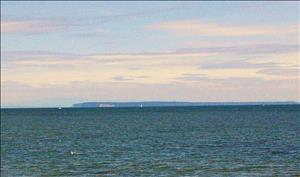This essay presents a description of a trip to Point Roberts (Whatcom County) on a summer day near the end of the first decade of the twentieth century. Point Roberts is a five-square-mile peninsula that is part of the United States, but that is not connected by land to the mainland of the United States. It extends from British Columbia, Canada, into the Pacific Ocean. Written by an unknown author, the article is reprinted from "Northwest Corner of the U.S.," The Blaine Journal, Homeseeker's Edition, April 1909, p. 8.
Northwest Corner of the U.S.
Fourteen miles west of Blaine, across the Gulf of Georgia, lies Uncle Sam’s most northwesterly possession in the United States proper, Point Roberts.
It is a bold headland extending from the British Columbia mainland south across the international boundary something like two miles.
During the winter months Point Roberts is a lonesome place, but in summer, during the fishing season, if the salmon run, the place is one bustling with activity. Around on the west shore there is a small town consisting of a few stores, a post office, saloon and the salmon cannery of George & Barker Company. This last is the big thing of the west shore. On the east side of the point is the immense cannery owned by the Alaska Packers Association.
A trip to Point Roberts in summer is well worth while. Boats make the run from Blaine and it is a trip out through the fish trips over as fine a body of water as one would wish to see. We will suppose that you leave Blaine on an afternoon boat. The water in all directions is smooth, save for the ripple made by the many fishing boats going to the Blaine or Point Roberts canneries with fish that will soon be inside a tin jacket. After getting out a couple of miles you look back and see the snow capped mountains of the Cascade range with their belt of green forests extending down to the rich valley farms. Away to the north, in British Columbia, are more snow caps and to the northwest the mirage shows the rich farm lands at the mouth of the Frazer [sic] River. Approaching Point Roberts the boat skirts the south shore, giving one a glimpse now and then of a farm house set in among the giant firs and cedars, showing where some one is making a home.
Passing around the end of the long sand spit, the boat turns north and, just as the sun sets beyond the mountains of Vancouver Island, pulls up at the landing and you alight on the George & Barker wharf. If you take time to look around you will see a most beautiful scene. Away to the south are the famous San Juan Islands with their many straits and passes. To the west Vancouver Island lies a barrier between the Gulf of Georgia and the Pacific Ocean; to the north is the delta of the Frazer River and the city of Vancouver, B.C. A large steamship outward bound to the Orient, passes down the gulf, perhaps mingling its smoke with that of a steamer sailing in an opposite direction to the golden land of Alaska. Twilight, that long mid-summer twilight of northern latitudes, comes on while you gaze at the beautiful scene. The cannery whistles blow and the day’s work there is over. The girls and boys who have been at work since early in the morning come out and go to their homes, or the many camps that have been made on the bluff, for Point Roberts’ population is largely a floating one and it camps there during the summer.
The Chinamen with their pails and long keen butcher knives come from the building at the end of the wharf where they have been butchering salmon, and go to the China house on the hill, their jumbled language and noisy clatter lending novelty to the surroundings. The camp fires are lighted, and after supper the music from the guitars, banjos and mandolins blend with the voices of those who sing and you soon see that those who work at Point Roberts during the fishing season are there more for an outing than what they make. If it happens to be a Saturday evening there will be a dance at the club house and the fun will last until a late hour, when the merry-makers will return to camp and enjoy the sweetest sleep upon a thick mat of fir or hemlock boughs spread upon the ground.
From the post office north to the northwest monument [of the border with Canada] is a walk of something over a mile, through thick woods of fir, cedar, alder and maple. The monument stands on top of the bluff and overlooks a wild scene of wood and water.
A walk of some three miles from the post office east over a trail that passes through the meadows of the farmers and through a fine body of second growth fir, will bring you to the top of the fortress looking bluff back of the A.P.A. Cannery. To get down this bluff is quite a proposition, but at its foot you will find a large spring of water, a drink of which will pay you for the long walk you have made. A short distance from the spring are the large buildings of the cannery. This is one of the largest canneries on the coast and is equipped with all the latest machinery for the rapid handling of large numbers of fish. It is under the same management as the A.P.A. cannery at Blaine. This, then, is Point Roberts, Uncle Sam’s northwest corner, and if you ever have a chance to see it, don’t miss it, for it will pay you.

